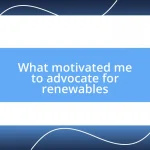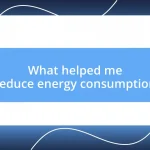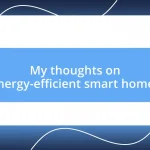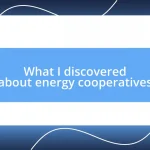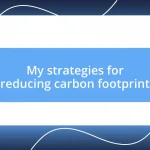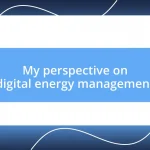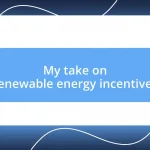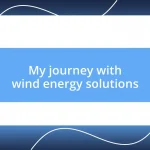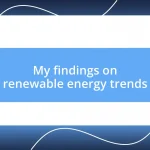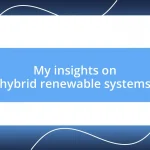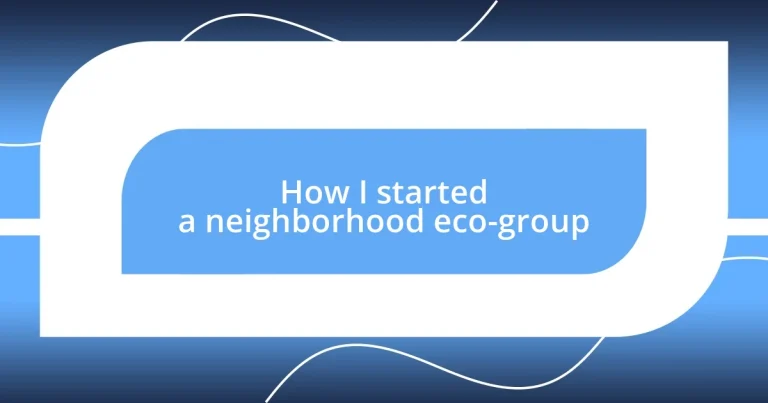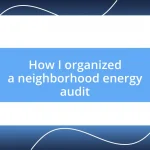Key takeaways:
- Identifying community needs led to the formation of an eco-group focused on reducing litter and increasing recycling options, enhancing both environmental awareness and community bonding.
- Engaging neighbors through small gatherings, door-to-door conversations, and social media fostered a collaborative spirit and commitment to creating a greener neighborhood.
- Building partnerships with local organizations and measuring impact through tracking progress and community feedback strengthened initiatives, aligned actions with community interests, and cultivated long-lasting change.
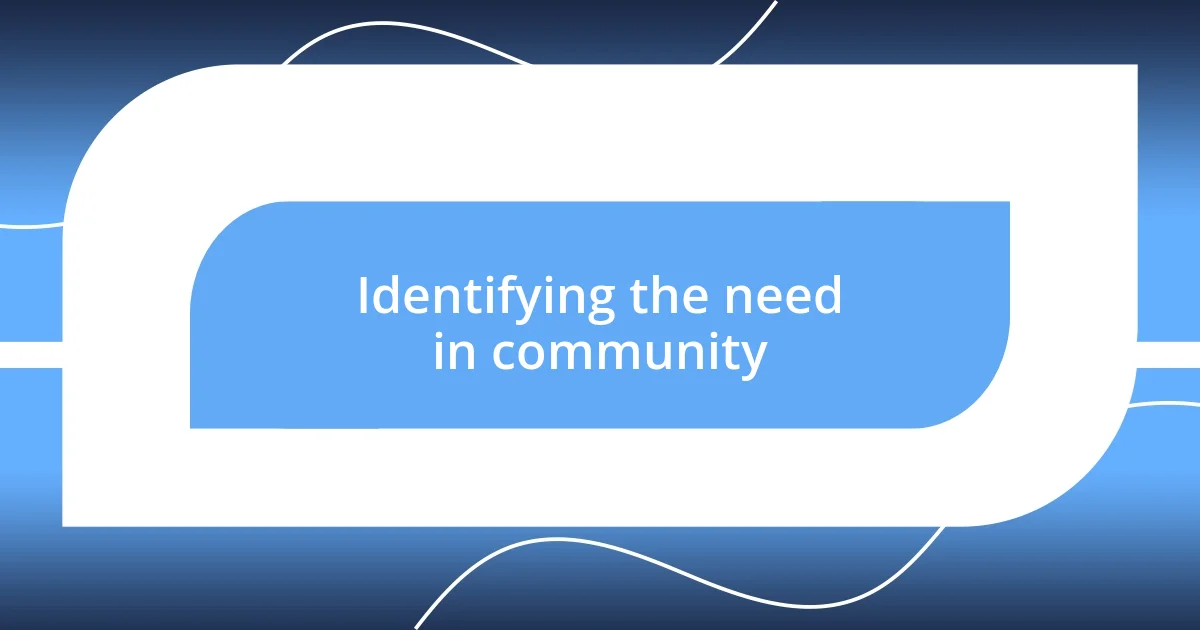
Identifying the need in community
Identifying the need in my community was a journey that began when I noticed litter piling up in our favorite park. I remember standing there one sunny afternoon, feeling a mix of frustration and sadness as I watched families enjoy the space, seemingly oblivious to the growing mess around them. It struck me: if we want our neighborhood to thrive, we must all take responsibility for its care.
As I spoke with neighbors, I discovered a shared concern about the lack of recycling options. “How can we teach our kids about sustainability if there are no bins around?” one mom asked, and I felt a deep resonance with her words. This moment illuminated a gap that needed to be addressed, sparking my curiosity about how I could rally others to take action.
Through conversations and observations, I uncovered not only environmental needs but also a strong desire for community bonding. It became clear that addressing these issues could foster connections—what if we could transform our shared love for the environment into regular clean-up days or informative workshops? Identifying these needs has been essential, shaping the direction of our eco-group and weaving the fabric of collaboration into our neighborhood.
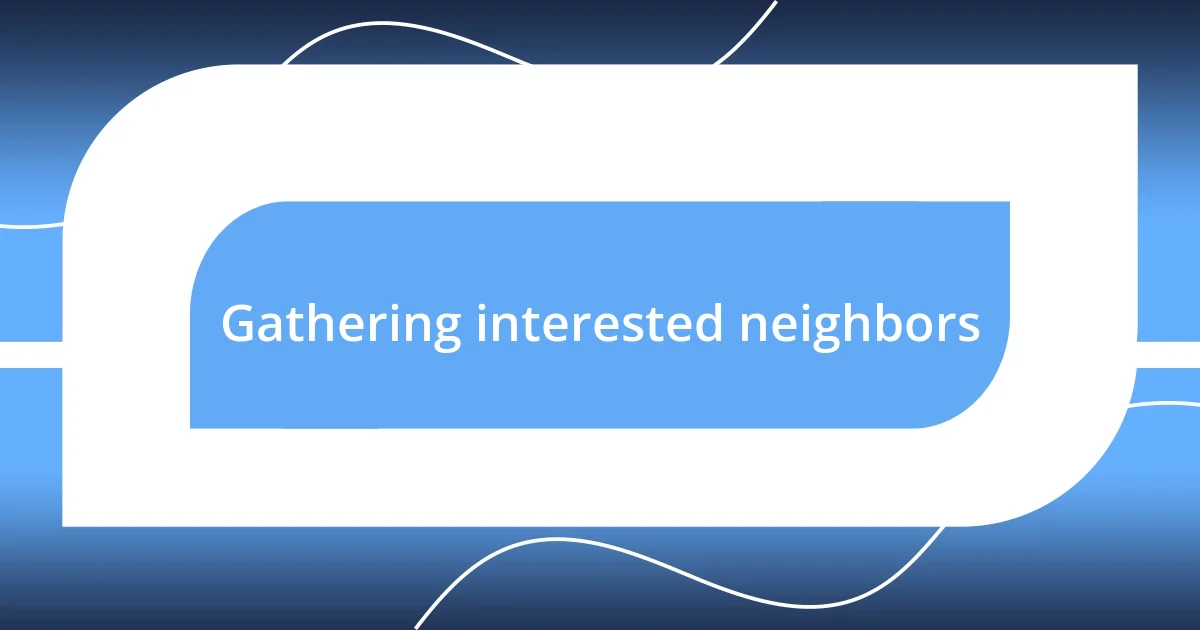
Gathering interested neighbors
Getting my neighbors on board was both thrilling and daunting. I organized a small gathering at my home, armed with ideas and a hopeful heart. As I brewed coffee, I casually floated the idea of an eco-group and invited anyone interested to join. To my delight, several neighbors showed up—some curious, others enthusiastic. I shared my vision, and the genuine interest in their eyes was contagious; we were all there for the same reason, wanting to make our neighborhood a greener, more vibrant place.
Engaging neighbors often requires stepping outside my comfort zone. I remember knocking on doors, nervously introducing myself and explaining my mission. Many times, I was met with surprising enthusiasm. One neighbor even jumped in with, “I’ve been wanting to do something about the trash on our block!” This reaffirmed my belief that most people want to help; they just need a nudge to get involved. By listening to their concerns and dreams for our community, I could create a space for everyone’s voice, making the initiative feel collaborative.
Social media proved to be an invaluable tool in gathering interested neighbors. I created a simple Facebook group where we could share thoughts, plan meetings, and post updates on local events. Each post sparked discussions and built excitement within our community. I felt a palpable shift as neighbors who barely spoke before began sharing ideas and resources, forming a vibrant eco-conscious network. It’s empowering to witness a community come together, united by a common purpose—a testament to the power of connecting people with shared values.
| Approach | Outcome |
|---|---|
| Small Gatherings | Fostered connections and enthusiasm. |
| Door-to-Door Conversations | Built personal relationships and commitment. |
| Social Media Engagement | Created an ongoing dialogue and resource sharing. |
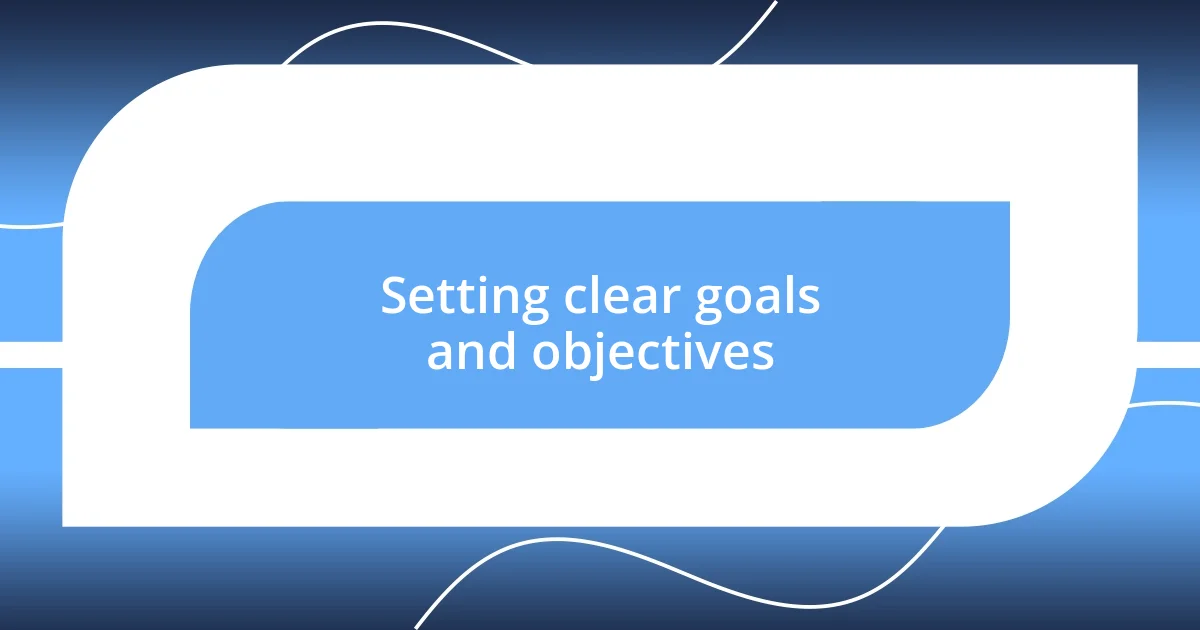
Setting clear goals and objectives
Setting clear goals and objectives is like drawing a roadmap for our eco-group. I remember when we first gathered to brainstorm our objectives; the room buzzed with energy and ideas. But as the discussions flowed, it became apparent that we needed to focus our enthusiasm into actionable steps. We decided to outline our goals, ensuring everyone felt connected to our mission. This clarity not only directed our efforts but also helped motivate those who joined us.
Here’s how we set our goals effectively:
- Identify Specific Areas of Focus: We honed in on key issues, like reducing litter in our parks and creating more recycling options.
- Establish Measurable Targets: For instance, we aimed to host one community cleanup event every month, charting our progress as we went.
- Encourage Community Participation: Setting objectives that invited everyone to engage made the group feel inclusive and motivated.
- Review and Revise Regularly: Each month, we checked in to see what was working and what needed adjustments, helping to keep our efforts aligned.
I still cherish those early meetings where we celebrated small victories—like when we increased recycling bins in the park. Each-time we accomplished something together, I felt our community grow a little closer, and our commitment to making a difference strengthened. By defining our goals clearly, we created a solid foundation for our eco-group that inspired collective action and lasting change.
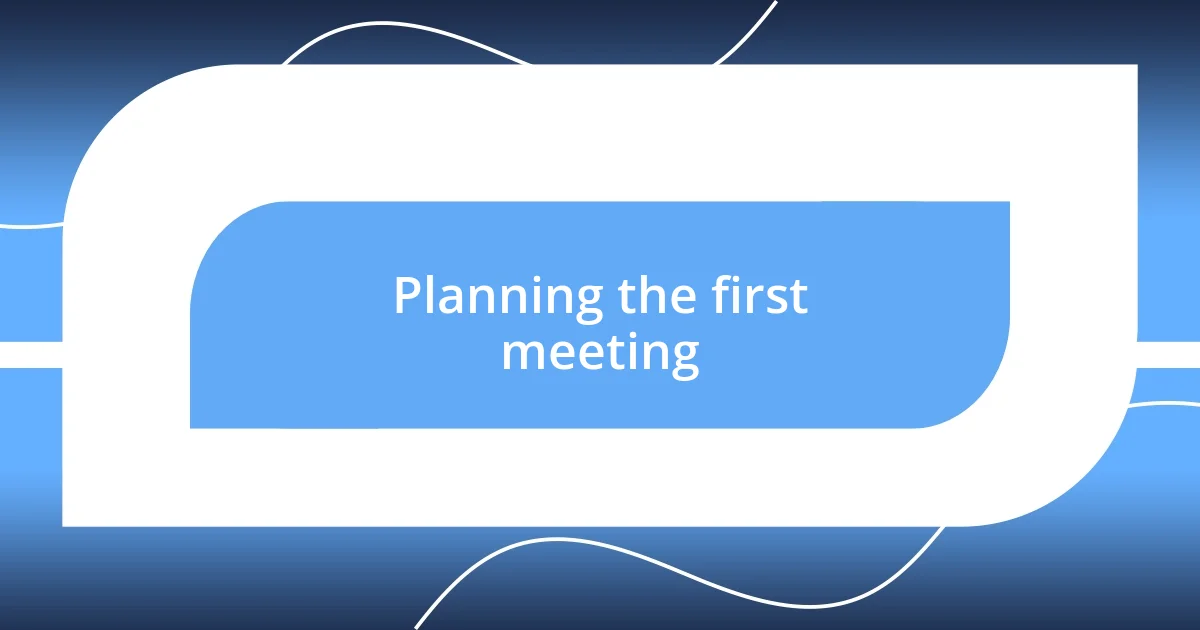
Planning the first meeting
Planning the first meeting was an exhilarating experience, but it also came with its share of anxiety. I vividly recall nearly forgetting the snacks as I made the final touches—who knew a plate of cookies could ease the nerves of sharing eco-friendly goals? I sent out a simple message to our budding group, letting everyone know that this would be our chance to not only meet but also brainstorm what we hoped our eco-group could achieve together.
As I sat down with my neighbors, each person echoed a sentiment that struck me deeply: “I really want to make a difference, but I don’t know where to start.” Hearing this made me realize how crucial the first meeting was in transforming that desire into action. I encouraged each person to share their ideas. It was heartwarming to see how passionate they were about everything from planting community gardens to organizing clean-up days. Those conversations not only sparked inspiration but truly bonded us as a team.
To ensure that the meeting flowed smoothly, I made a simple agenda, which was more of a guide than a strict plan. We chatted about our individual goals, but I also prompted discussions with open-ended questions like, “What specifics would you like to see implemented?” This not only kept everyone engaged but also created a safe space for new ideas to flourish. Reflecting on that night, I felt a swell of hope; it was when our sharing turned into a real commitment. We were laying the groundwork for not just an eco-group, but a united community striving for change.
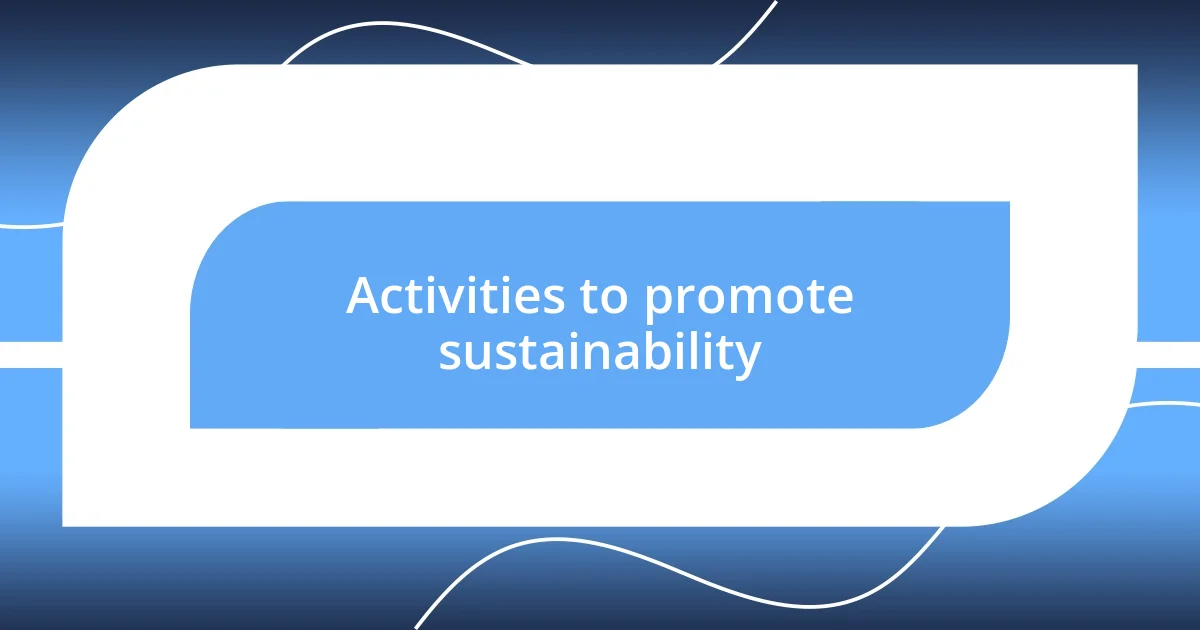
Activities to promote sustainability
One of the most impactful activities we initiated was organizing monthly clean-up events. I can still remember the thrill of seeing neighbors walking together with trash bags, laughing and chatting as we picked up litter from our local park. It was refreshing to witness not just the improvement of our environment, but the deepening of friendships among participants. Have you ever experienced that sense of community that comes from working side-by-side with others towards a common goal? It’s that powerful feeling that can spark lasting change.
We also found immense value in establishing educational workshops. These sessions were designed to teach practical skills, such as composting and upcycling. I distinctly recall when we held our first composting workshop—I was blown away by the turnout. Neighbors excitedly brought their kitchen scraps, eager to learn how they could reduce waste. The conversations that ensued were rich with personal stories and shared challenges, making it clear that our group was rooted in a genuine desire to learn and grow together.
To engage the younger generation, we started a “Green Challenge” for local schools, where children were invited to submit their ideas for sustainability projects. I can vividly picture the sparkle in their eyes as they brainstormed creative solutions. Their enthusiasm reminded me of how children can be powerful advocates for change, inspiring their families to participate too. It’s moments like these that reinforce my belief: when we plant the seeds of sustainability in young minds, we cultivate a brighter, greener future for everyone.
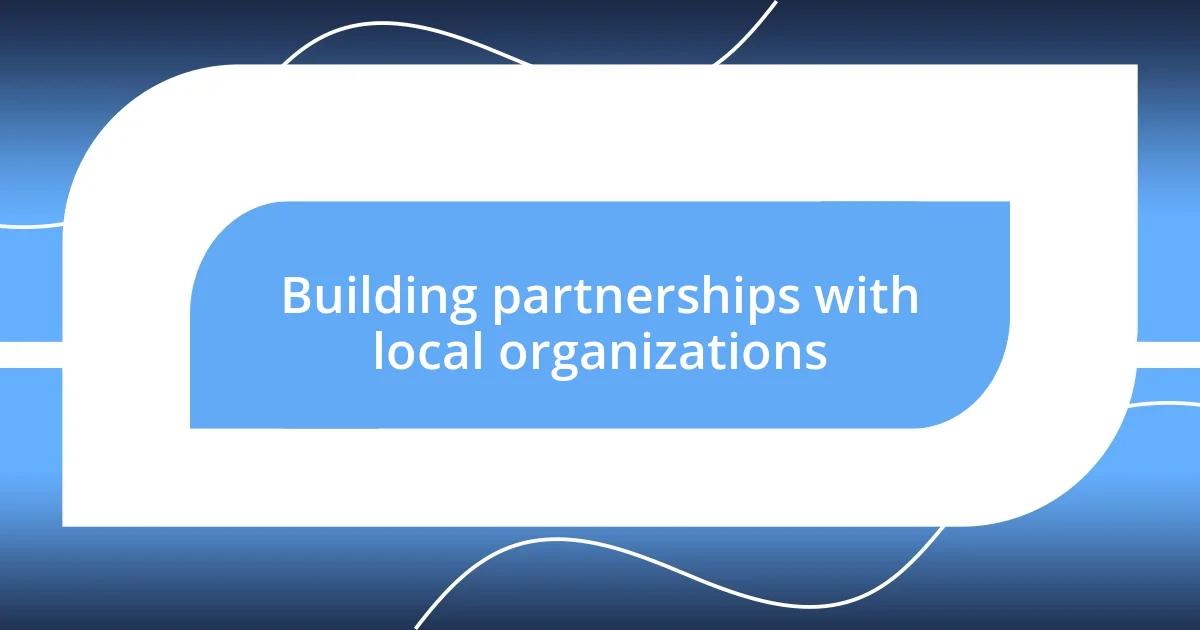
Building partnerships with local organizations
Building strong partnerships with local organizations was one of the most transformative aspects of our eco-group development. I remember reaching out to the nearby community center, thinking they might be interested in collaborating on an event. When they agreed to host our first workshop, I felt a rush of excitement—it was a validation of our goals. Partnerships like these not only broadened our outreach but also provided resources we hadn’t anticipated, making our collective impact much stronger.
I’ve found that connecting with local businesses can be equally enriching. For instance, we approached a local garden center for sponsorship. I had a heartwarming conversation with the owner, who suggested donating materials for our community garden. It felt wonderful to see a local business share our vision. Those kind of connections cultivate a spirit of community that goes beyond transactional relationships; they foster genuine support among neighbors.
Moreover, I’ve learned that establishing rapport with environmental organizations can elevate our initiatives. I distinctly recall attending a meeting with a non-profit dedicated to sustainability. The insights they provided about grants and resources transformed our planning process. Have you ever had a moment where someone’s shared experience instantly simplified a daunting task? That was my experience, revealing how invaluable such partnerships can be for accelerating our mission. Each collaboration reinforced the idea that together we could amplify our efforts and truly make a difference in our neighborhood.
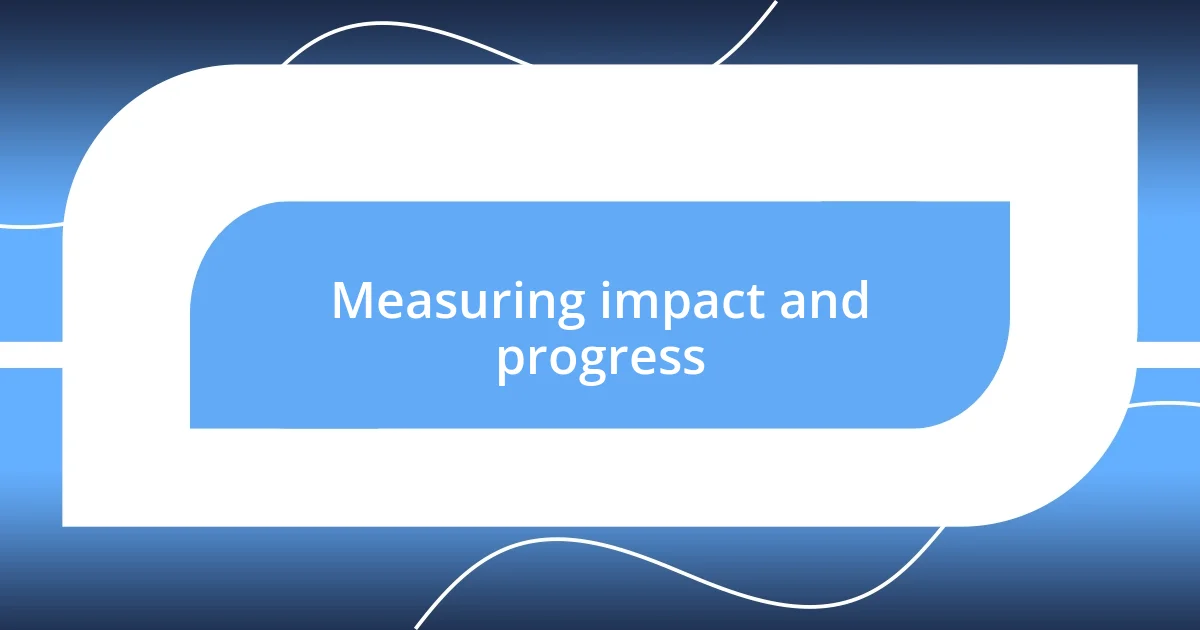
Measuring impact and progress
Measuring our impact and progress was a critical part of our eco-group’s journey. I recall the moment we decided to create a simple tracking system for our clean-up events. We wrote down the amount of trash collected and the number of participants each month. It was enlightening to see those numbers grow over time, and it gave me a tangible sense of accomplishment. Have you ever experienced the motivation that comes from visualizing your progress? That’s precisely what it did for us.
As our initiatives expanded, we began gathering feedback from participants. After each workshop, I would ask for written reflections on what people learned. I still smile when I think about a heartfelt note from a neighbor expressing how the composting workshop changed her family’s habits. Warm moments like that highlight the real-life impact of our efforts and remind me that each small change can lead to significant shifts in our community’s mindset.
We also initiated an annual survey to better understand our members’ evolving interests and effectiveness of our programs. I remember sitting in front of my computer, analyzing the results, and realizing that more than 70% of respondents wanted to focus on renewable energy. That moment was pivotal. It made me realize how important it is to listen to our community, ensuring our actions align with their aspirations. Isn’t that what being a community is all about? Creating a space where everyone feels heard and valued?


